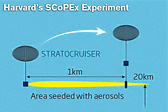Climate security

Geoengineering seems to be the new darling idea making the rounds of the science and technology media. But what is geoengineering? Loosely speaking, the term refers to deliberate manipulation of the Earth’s ecosystem so as to achieve some desired climate effect—usually a cooling to offset the effects of human-caused global warming. Many researchers who have studied the subject are uncomfortable with the word “engineering” applied to meddling with a system we still understand rather poorly, so other terms—such as “Hacking the planet”—have come into play. In
National Research Council reports on the subject, of which I was a co-author, we settled on the term “Climate Intervention,” which carries less freight in assuming that the undertaking will necessarily achieve the desired end.
Climate intervention comes in two main flavors. One is albedo (i.e., reflectivity) modification, which involves putting something in the atmosphere to reflect more sunlight back out into space. The other is carbon dioxide removal and sequestration, which involves removing carbon dioxide from the atmosphere and stowing it somewhere where it will hopefully stay put for a few thousand years. The latter technique is relatively benign, though highly technologically challenging. It is albedo modification, which has some truly terrifying implications, which I will be concerned with here.
No comments:
Post a Comment